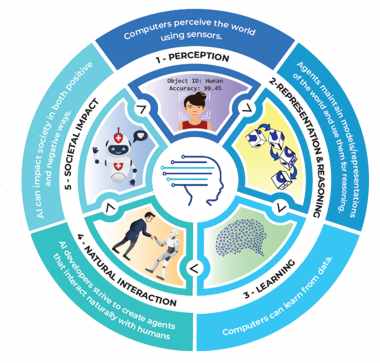| Artificial Intelligence for K-12 |
| Written by Nikos Vaggalis |
| Monday, 03 June 2019 |
|
The AI for K-12 Initiative wants to kick-start the discussion on how to incorporate learning about AI in the United States school curriculum, ultimately leading to national guidelines.
The AI for K12 working group led by Professor David Touretzky, an AI researcher at Carnegie Mellon University was announced a year ago by the AAAI (Association for the Advancement of Artificial Intelligence, formerly the American Association for Artificial Intelligence). The project is in collaboration with the Computer Science Teachers Association and AI4All, a nonprofit that works to increase diversity and inclusion in artificial intelligence. The guidelines, will define what students should know about artificial intelligence, machine learning, and robotics., are modeled after the CSTA standards for computing education and address grade bands K-2, 3-5, 6-8, and 9-12, hence teaching about AI looks like is going to be considered at par with the rest of the core subjects such as Math's and English. The project's other purpose is to host a curated Resource Directory that facilitates AI instruction and fosters collaboration among the K-12 AI resource developer community. This initiative marks another attempt to supply the coming generations with the tools to cope in a landscape shaped by the 4th Industrial Revolution.The reasoning goes that in the near future and in one way or another, AI will affect most aspects of our lives, therefore kids should not just become consumers of this technology, they also have to be able to work with it in order to create solutions which collectively will make the world a better place. For that reason the curriculum also incorporates the issue of Ethics in AI and promotes the racial and gender diversity of the participants in order to eradicate the associated bias. Another reading would be that times change fast and that as well as teaching the concepts of coding at school, coding should be dedicated to making AI applications. Attempts to teach kids coding for AI applications are not something new. For example, Minecraft is one of the possible options available, but until now it was up to the individual schools, teachers, parents or volunteers to make something of it. It's this void that AI4K12 attempts to fill in organizing matters into something holistic and nationwide. Furthermore, this could also be an attempt to join the AI arms race in education which is already taking place amongst nations, some already having made significant advances - with China having published its first AI textbook for high school students in 2018. The planned curriculum's grand overview would be to mentor students in a way so that they become able to: Evaluate and apply information technology, including new or unfamiliar technologies, analytically to solve problems It's going to be structured in relation to the grade bands: 5-7: recognize common uses of information technology beyond school 7-11: use and combine a variety of software (including internet services) to create, systems and 11-14: undertake creative projects that involve using, and combining multiple applications, to 14-16: develop and apply their analytic, problem-solving, design, and computational thinking 16-18 (AQA): project suggestions include an application of artificial intelligence; investigating an area of data science using, for example, Twitter feed data or online public data sets; and investigating machine learning algorithms. and will revolve around 5 big ideas that are considered representative of the field but at the same time small enough to be manageable by teachers:
Big Idea #1: Perception Students should be able to identify types of sensors and their limitations.This involves: ● Speech recognition Big Idea #2: Representation and Reasoning Students in grades 6+ should be able to draw a search tree.This involves: ● Knowledge representation Big Idea #3: Learning - “Computers can learn from data” Students should be able to train a classifier.Grades K-2: train a gesture discriminator.Grades 6-8: define a feature set and train a ● Machine learning Big Idea #4: Natural Interaction - “AI developers strive to create agents that interact naturally with humans” Grades K-2: students should be able to converse with an ● Natural language understanding Big Idea #5: Societal Impact - “Artificial Intelligence can impact society in both positive and negative ways.” Grades 6+: Students should be able to identify ethical 42 issues raised by AI applications. ● Ethics: what sorts of applications are desirable/permissible? It will also incorporate several student activities: ● AI Experiments and projects that show: Glancing at the syllabus it really looks a thorough introduction to the field. For more information, to join the brainstorming, provide feedback or contribute in any way, for example in developing material, you can visit the project's main page over at Github or join its mailing list at ai4k12@aaai.org. Whether AI4k12 will make an impact on the life long battle of education, which begins at the early years and lasts till old age, will tell very soon. One thing is for sure though, that in this battle the participants' age is ever decreasing. More Information
Related ArticlesAn analysis of the Ethics Guidelines For Trustworthy AI guidelines SAP's Creating Trustworthy and Ethical Artificial Intelligence Computer Science Curriculum From Minecraft
To be informed about new articles on I Programmer, sign up for our weekly newsletter, subscribe to the RSS feed and follow us on Twitter, Facebook or Linkedin.
Comments
or email your comment to: comments@i-programmer.info |
| Last Updated ( Monday, 03 June 2019 ) |




